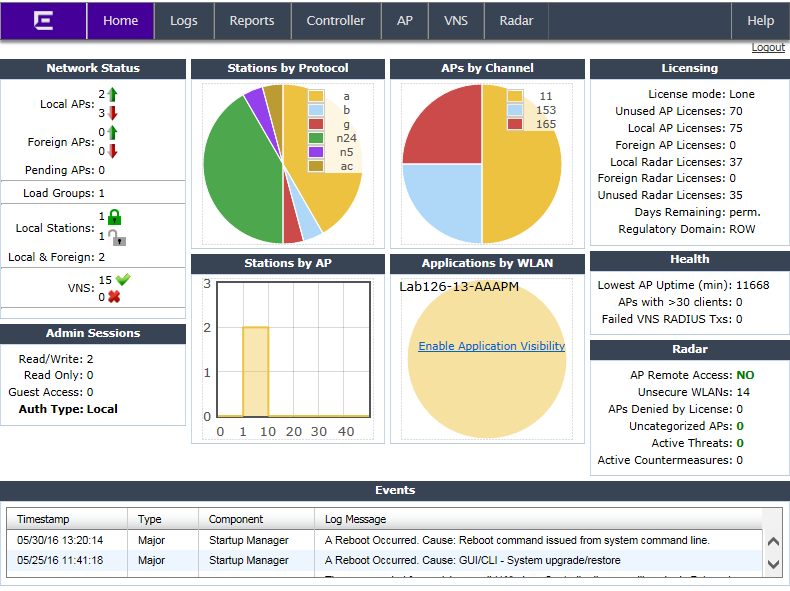The Wireless Assistant Home Screen provides real-time status information on the current state of the wireless network. Information is grouped under multiple functional areas, and the Wireless Assistant Home Screen provides a graphical representation of information related to the active APs (such as the number of wired packets, stations, and total APs). Navigate the Wireless Assistant using the top menu bar tabs.

The bottom status bar displays the type and description of the current wireless controller, user and admin login status, flash status, software version and the number of admin users currently logged into the controller.

Wireless Assistant Home Screen describes the panes on the Wireless Assistant Home Screen.
Wireless Assistant Home Screen
| Home Screen Heading | Description |
|---|---|
| Network Status | Includes real-time totals for the
following components. Click the number displayed to display additional
information, such as name, serial number, and IP address.
|
| Admin Sessions | Displays information on the total number of
recent administrative activities including:
Click each heading to access the screen. For more information, see Configuring the Login Authentication Mode. |
| Stations by Protocol | Displays a graphical representation of the total
number of active stations grouped by protocol. Click the Stations by Protocol heading to access the All Active Clients Report. For more information, see Viewing Statistics for APs. |
| APs by Channel | Displays a graphical representation of the total
number of active stations and the number of APs. Click the APs by Channel heading to access the Active Wireless AP Report. For more information, see Viewing Statistics for APs. |
| Stations by AP | Displays a graphical representation of the total
number of active APs grouped by channel. Click the Status by AP heading to access the Active Clients by Wireless APs Report. For more information, see Viewing Statistics for APs. |
| Applications by WLAN (Wireless Local Area Network) | If
Application Visibility is enabled on the WLAN
Configuration screen, a pie chart displaying the top five
applications on that WLAN displays. If Application Visibility is not
enabled, click Enable
Application Visibility to display the Apps, operating
systems, and devices used by clients. The
Application Visibility option displays the following information for
clients associated with a selected WLAN:
|
| Licensing | Displays licensing information including:
Click the Licensing heading to access the screen. For more information, see Installing the License Keys. |
| Health | Displays network health statistics including:
Click each heading to access the Active Wireless APs Report. For more information, see Viewing Statistics for APs. |
| Radar | Displays totals for the following security
related statistics:
For more information, see Wireless AP Registration, and Working with Radar Reports. |
| Events | Displays major events that impact network
performance and efficiency. Each event listed includes a timestamp of
the event, the type or classification of the event, which component is
impacted by the event, and a log message providing specific information
for the event. Click the Events heading to access the page. For more information, see Working with Reports and Statistics. |